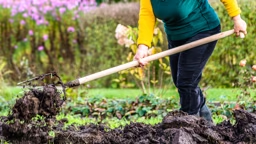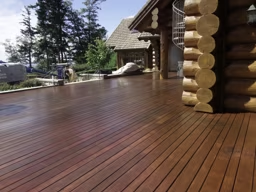
Photo: Courtesy Perma-Chink Systems
Over the course of a log home’s lifespan, its stain will require periodic touch-ups, particularly on the southern-facing exposure where exterior walls are most subjected to the sun’s harsh UV rays. This regular staining requirement is part of routine log home maintenance, just as wood-siding needs to be repainted and vinyl-siding has to be replaced if it cracks. Even brick houses require occasional cleaning and mortar repair.
Though giving a wall a fresh coat of stain is pretty straightforward (clean the logs; let them dry completely; reapply the stain), there are a host of reasons why you may consider stripping the present stain off the wood and starting from scratch. Maybe you bought an existing or antique log home and you don’t know what type of stain product or shade was originally applied. Perhaps the previous owner was not as diligent as he should have been when it came to exterior maintenance and you want to re-do it right. Or, perhaps you’ve been in your home for 20 years and you want to change the color. In each of these scenarios, getting down to the bare wood as best you can is essential to achieving optimal results, and stripping the logs of their previous stain product is the way to do that.
Removal Methods
In most cases, media blasting is the best way to remove stain quickly and easily. Over the years, log refinishing and refurbishing companies have experimented with a variety of media: sand, corncob grit, glass pellets, walnut shells — even baking soda and dry ice. Each of these materials has been shown to be efficient at removing existing finish from logs, but there are a few things to consider.
Though effective, the nature of corncob grit runs the danger of depositing and lodging organic material into the logs’ surface, which could cause mold to take hold. Inorganic materials like sand or glass won’t leave matter or residue behind. Walnut shells have proven to be an excellent middle ground. They’re organic, but because they are so hard, they act more like glass pellets and won’t impregnate the wood with particles that could mold later on. Then, there are the more obscure materials: baking soda and dry ice. Easy cleanup is an advantage both of these options share that the others do not. Baking soda washes easily and dry ice simply melts away. Not only are these attributes good for the logs, they won’t harm your landscaping or the environment at large.
You may think: Can’t I just sand it off with a belt sander and avoid all the debris caused by the media? Well, you can, but sanding produces a lot of dust on its own, which is no picnic to clean up. Also, it’s difficult to get sandpaper into log checks and around corner systems, so you run the risk of not removing all of the stain. Media blasting gets into the tightest nooks and crannies.
Of course, there are very effective and user-friendly chemical strippers on the market, but a downside to these products is that they simply soften the finish, so you’ll need a power washer to remove it. You’ll also need to protect plants from the product, and you’ll have to thoroughly rinse the logs to remove all of the chemicals before applying the new stain — a potential issue if the logs you’re stripping are inside of your home.
Water- or Oil-based?
One of the nuances that could affect your log home’s stain removal is whether the product that’s on the wood is water- or oil-based. This is important to know, as it could impact the methods used to strip the logs, the length of time involved and the cost.
As a rule, water-based or acrylic stains are easier to remove because the majority of the product sits on the surface of the log, with only a small amount seeping into the top-most layer of wood fiber.
The thing that makes oil-based stains so attractive to log home owners is also the thing that makes them more difficult to remove: The product penetrates deep into the wood grain, meaning that you may have to go deeper into the logs to purge it. It’s not impossible, but it may take more effort, resulting in increased costs.
See also: How to Choose a Log Home Stain
The Bottom Line
Be prepared — it’s not uncommon to spend $15,000 to $25,000 to strip and re-stain a log home, depending on its size and region of the country. There’s a bit of an art to stripping stain from log walls, so this is one of those times when spending the money to hire a pro (someone with log refurbishing experience, not just a professional painter) will save you a lot of headaches — and wallet-aches — down the line.
But if you consider yourself pretty handy and want to give it go on your own, there are resources to help you succeed. Stain and sealant manufacturer Sashco, Inc. has excellent free tutorials on YouTube to guide you. If you give it a try, protect yourself. Proper eyewear (with side shields), a respirator mask, gloves and long sleeves and pants are essential for your safety.
Whether you enlist the help of a contractor or decide to go it alone, a thorough strip will ensure that your newly applied stain will not only look great, it will last.
See also: What to Expect in a Log Home Restoration
About the Author: Dan Mitchell is a builder and a Log & Timber Home University professor. He owns Eagle CDI, a construction firm based near Knoxville, Tennessee.











